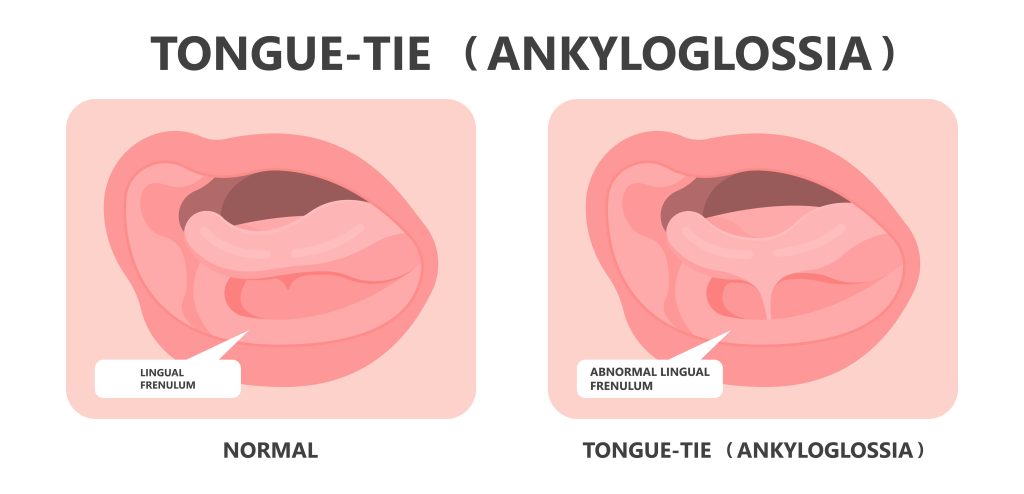Tongue Tied Babies (Ankyloglossia) Signs, Causes & Treatment
Do you find your baby struggling with feeding or experiencing challenges with breastfeeding? Are you curious about tongue tied babies and its potential impact on their oral health and development? Understanding the nuances of ankyloglossia, commonly known as tongue-tie, is vital for parents seeking to provide the best care for their little ones.
In our comprehensive guide on “Tongue Tied Babies (Ankyloglossia) Signs, Causes & Treatment”, we delve deep into this often-overlooked topic, aiming to shed light on the signs, reasons behind, and effective solutions for this condition.
Let’s steer through the complexities of tongue-tie together to equip you with the knowledge needed to make informed decisions about your baby’s well-being.
Throughout this exploration, we will address common concerns such as breastfeeding challenges, tongue mobility issues, and their potential impact on speech and oral motor skills.
Join us as we uncover evidence-based information, expert insights, and practical advice to support you on your parenting journey.
Introduction to Tongue-Tie

Tongue-tie, scientifically known as ankyloglossia, is a condition where the lingual frenulum, a band of tissue that connects the tongue to the bottom of the mouth, is shorter or tighter than usual. This restricts the movement of the tongue, affecting various aspects of a baby’s oral health and feeding.
- Babies with tongue-tie may experience challenges while breastfeeding, as the limited range of tongue motion can impede their ability to latch onto the breast effectively.
- This can result in breastfeeding difficulties, such as inadequate milk transfer and discomfort for both the baby and the breastfeeding parent.
- Beyond breastfeeding, tongue-tie can potentially affect a baby’s overall oral motor skills and speech development in the long run.
- It’s important to note that tongue-tie severity can vary, ranging from mild to severe.
Being aware of tongue-tie and its potential impact is crucial for parents to ensure their baby’s well-being.
In the following sections, we will delve deeper into the causes, signs, diagnosis, and treatment options for tongue-tie, as well as provide support and guidance for breastfeeding and caring for tongue tied babies.
What is Tongue-Tie?

Tongue-tie, medically known as ankyloglossia, is a condition that affects the movement of the tongue due to the presence of a short or tight lingual frenulum. The lingual frenulum is a band of tissue that connects the underside of the tongue to the floor of the mouth.
In babies with tongue-tie, the lingual frenulum is either too short or restricts the tongue’s range of motion, impacting various oral functions. This can cause difficulties in breastfeeding, speech development, and overall oral health.
Causes of Tongue-Tie
Tongue-tie can be present at birth and is often a congenital condition. The exact causes are not fully understood, but research suggests it may be due to genetic factors or abnormal tissue development during fetal development.
The tight or short lingual frenulum can range in severity, from mild cases that may not cause noticeable issues to more severe cases that significantly affect tongue movement.
It’s important to note that tongue tie is not caused by the parents’ or the baby’s actions or behaviors.
Role of the Lingual Frenulum
The lingual frenulum plays a crucial role in various oral functions. In babies with ankyloglossia, the lingual frenulum restricts the range of motion of the tongue, making it difficult to properly latch and suckle during breastfeeding. This can lead to challenges for both the baby and the breastfeeding parent.
In addition to breastfeeding difficulties, tongue-tie can also affect speech development. The limited movement of the tongue can make it harder for the child to articulate certain sounds, potentially impacting their ability to communicate effectively.
It’s important to note that tongue-tie varies in severity and its impact can differ from person to person. If you suspect your baby may have tongue-tie, it’s recommended to consult with a healthcare provider or lactation consultant for a proper diagnosis and guidance on treatment options.
Tongue-tie is a condition where the lingual frenulum restricts the movement of the tongue, leading to difficulties in breastfeeding and potential impact on speech development. Understanding the definition and causes of tongue-tie is crucial for parents to seek timely support and guidance.
If you have concerns about your baby’s tongue-tie, reach out to healthcare professionals who can provide an accurate diagnosis and recommend appropriate treatment options.
Identifying Tongue-Tie in Babies

Recognizing the signs and symptoms of tongue-tie in infants is crucial for early identification and intervention. Here are key indicators that may suggest your baby has tongue-tie:
1. Difficulty breastfeeding
Tongue-tied babies often experience challenges during breastfeeding. They may struggle to latch properly onto the breast, leading to inadequate milk transfer and poor weight gain.
2. Limited tongue movement
One of the most evident signs of tongue-tie is reduced mobility of the tongue. You might notice that your baby’s tongue cannot extend beyond the lower gums or move sideways effortlessly.
3. Clicking or popping sounds during feeding
Due to an improper latch caused by tongue-tie, you may hear clicking or popping noises while your baby feeds. These sounds imply inefficient suction and difficulty maintaining a proper seal on the breast.
4. Prolonged feeding sessions
If your baby takes an unusually long time to nurse or seems easily fatigued during feeding, it could be an indication of tongue-tie. The restriction of tongue movement can hinder effective milk transfer, leading to prolonged sessions.
5. Poor weight gain
Tongue-tied infants may struggle to gain weight adequately due to inefficient feeding. If your baby’s weight gain is consistently below expectations, it’s important to consider the possibility of tongue-tie.
If you observe these signs in your baby, it’s recommended to consult a healthcare provider or a lactation consultant for a thorough assessment and diagnosis. Early identification and appropriate treatment can significantly improve feeding and overall oral development.
Diagnosis and Evaluation: Tongue Tied Babies

Diagnosing tongue tied babies is an essential step in understanding and addressing this condition. Healthcare providers, including pediatricians and lactation consultants, play a crucial role in the evaluation process.
Here’s an overview of how tongue tied babies are diagnosed and evaluated:
1. Clinical Assessment
- Healthcare providers carefully examine the baby’s tongue and assess its movement and appearance.
- They observe breastfeeding sessions to identify any difficulties or challenges related to tongue movement and latching.
- The appearance of the lingual frenulum, the band of tissue underneath the tongue, is evaluated to determine if it restricts tongue function.
2. Parental Input
- Parents are encouraged to share any concerns they have noticed regarding their baby’s feeding habits, speech development, or oral motor skills.
- Providing a detailed medical and breastfeeding history can aid in the diagnosis.
3. Collaboration
- Healthcare providers often work alongside lactation consultants, who specialize in breastfeeding support and can offer valuable insights during the evaluation process.
- Collaborative efforts help ensure a comprehensive assessment of the baby’s tongue-tie.
4. Referral
- In some cases, healthcare providers may refer the baby to specialists such as pediatric dentists, speech-language pathologists, or oral surgeons for further evaluation or treatment.
Early diagnosis and evaluation are crucial to effectively treating tongue-tie. By involving healthcare providers and lactation consultants, parents can gain valuable insights and guidance to support their baby’s oral health and breastfeeding journey.
Working closely with healthcare providers and lactation consultants allows for a comprehensive evaluation of your baby’s tongue-tie, enabling effective management and support.
Treatment Options for Tongue Tied Babies
When it comes to treating tongue-tie, there are various options available, ranging from non-invasive interventions to surgical procedures. The choice of treatment depends on the severity of the condition and the specific needs of the baby.
Here are the different treatment options for tongue-tie:
1. Lingual Frenotomy/Frenulotomy
- This is a simple, quick, and relatively minor surgical procedure that involves snipping or releasing the tight lingual frenulum.
- It is usually performed by a healthcare provider, such as a pediatrician or an ear, nose, and throat (ENT) specialist.
- The procedure aims to improve tongue mobility and facilitate better breastfeeding.
2. Laser Frenuloplasty
- This is another surgical option for treating tongue-tie.
- It involves using a laser to precisely remove or reshape the tight frenulum.
- Laser frenuloplasty is considered less invasive compared to traditional surgery, and it may result in less pain and quicker healing.
- However, it may not be available in all healthcare settings.
3. Stretching Exercises
- In some cases, healthcare providers may recommend gentle stretching exercises for the lingual frenulum.
- These exercises involve regular, controlled stretching of the frenulum to gradually increase its flexibility and improve tongue movement.
- However, it’s important to note that stretching exercises alone may not be effective for severe cases of tongue-tie.
4. Osteopathic Manipulation
- Some parents turn to osteopathic manipulation, a form of hands-on therapy, to address tongue-tie.
- Osteopaths use gentle techniques to release tension and improve overall body alignment, which may indirectly benefit tongue mobility.
- However, the effectiveness of this approach for treating tongue-tie is still a subject of debate, and further research is needed.
It’s crucial to consult with a healthcare provider or a qualified specialist, such as a pediatric dentist or a lactation consultant, to determine the most suitable treatment option for your baby.
They will consider factors such as the severity of the tongue-tie, the impact on breastfeeding, and any additional feeding or speech concerns.
Remember, early diagnosis and intervention can significantly improve feeding habits, speech development, and overall oral health in tongue tied babies. Seeking expert advice and exploring the available treatment options will help you make an informed decision and provide the best support for your baby’s well-being.
Breastfeeding and Tongue-Tie

Breastfeeding can be a beautiful bonding experience between a mother and her baby. However, when a baby has tongue-tie, it can present challenges that impact successful breastfeeding.
Tongue-tie, also known as ankyloglossia, is a condition in which the lingual frenulum, a band of tissue underneath the tongue, is tight or short, restricting tongue movement.
Challenges Faced by Breastfeeding Mothers
Mothers of babies with tongue-tie often encounter difficulties during breastfeeding. These challenges can include:
1. Poor latch
Babies with tongue-tie may struggle to open their mouths wide enough to latch onto the breast properly. This can result in ineffective or shallow latching, causing nipple pain or discomfort for the mother.
2. Insufficient milk transfer
Due to the limited movement of the tongue, babies with tongue-tie may have difficulty extracting milk from the breast efficiently. This can lead to inadequate milk intake, poor weight gain, and concerns about insufficient nutrition.
Tips and Strategies to Overcome Breastfeeding Challenges

Fortunately, there are strategies that can help breastfeeding mothers overcome the challenges associated with tongue-tie. Here are some tips to consider:
1. Seek support
Consult with a lactation consultant, who can provide guidance and support tailored to your specific situation. A lactation consultant can assess your baby’s latch and suggest techniques to improve breastfeeding.
2. Optimize positioning
Experiment with different breastfeeding positions to find the one that works best for you and your baby. Positions that encourage deeper latch and better tongue movement, such as the “laid-back” or side-lying position, can be beneficial.
3. Express milk
Using a breast pump to express milk can help maintain milk supply and provide feeding options when direct breastfeeding is challenging. This can be especially helpful during the early stages of breastfeeding, while working on improving latch and tongue movement.
4. Follow baby’s cues
Pay attention to your baby’s hunger cues and feed frequently. Frequent feeding can help stimulate milk production and ensure that your baby is adequately nourished.
5. Consider additional support
If necessary, consult with other healthcare professionals, such as a pediatric dentist or speech-language pathologist, who specialize in tongue-tie and its impact on breastfeeding.
Remember, each breastfeeding journey is unique, and what works for one mother and baby may not work for another. Don’t hesitate to reach out to a healthcare provider for personalized advice and support.
Breastfeeding should be a positive experience for both you and your baby. By seeking the right support and implementing strategies to overcome breastfeeding challenges associated with tongue tied babies, you can nurture a strong bond while giving your baby the nourishment they need for healthy growth and development.
Supporting Tongue Tied Babies

When parents discover that their baby has a tongue-tie, it is natural to have concerns and questions. Fortunately, there are various ways to support the growth and development of tongue tied babies.
Here are some valuable tips and resources for parents:
1. Seek Professional Guidance
- Consulting with a healthcare provider specializing in tongue-tie, such as a pediatric dentist or a lactation consultant, is crucial.
- They can provide a careful examination of your baby’s condition and offer expert advice tailored to your specific situation.
- They will also assess the impact of tongue-tie on breastfeeding and provide guidance on techniques to improve your baby’s latch and ensure efficient milk transfer.
2. Breastfeeding Support
- Breastfeeding can be challenging for babies with tongue-tie, but with the proper techniques and support, it can still be a successful and rewarding experience.
- Lactation specialists and consultants can guide you through different feeding positions, optimal latch techniques, and strategies to maximize milk supply.
- They can also evaluate any concerns related to tongue function and suggest interventions or exercises to improve tongue mobility and oral motor skills.
3. Specialized Therapies
- In some cases, additional therapies may be recommended to support your baby’s overall development.
- Speech-language pathologists are experts in assessing and addressing speech development concerns.
- They can provide specialized exercises and interventions to optimize your baby’s language skills and ensure proper articulation.
4. Online Communities and Support Groups
- Connecting with other parents who have experienced or are currently facing the challenges of tongue-tie can provide invaluable support and reassurance.
- Online communities and support groups dedicated to tongue-tie and breastfeeding can offer a wealth of shared experiences, tips, and emotional support.
- Hearing firsthand stories from other parents can help alleviate any anxieties and provide a sense of belonging.
Remember, every baby and situation is unique, so it’s important to consult with healthcare professionals for personalized guidance. With the right support and resources, parents can help their tongue tied babies thrive and overcome any challenges associated with tongue-tie.
Potential Long-Term Effects

Untreated tongue-tie can have lasting effects on a child’s oral health and overall development. It is important to address this condition early to avoid potential complications in the long run.
Here are some of the potential long-term effects of untreated tongue-tie:
1. Speech and Language Development
Untreated tongue-tie can impact speech clarity and articulation. It may lead to difficulties in pronouncing certain sounds, which can affect a child’s ability to communicate effectively.
2. Dental Issues
Tongue-tie can contribute to dental problems such as misalignment of teeth, improper bite, and tooth decay. The restricted movement of the tongue can affect proper chewing and swallowing, leading to issues with oral hygiene and development.
3. Feeding Challenges
Tongue-tie can interfere with proper latching and breastfeeding in infants. If left untreated, it can result in poor weight gain, insufficient milk supply, and frustration for both the baby and the breastfeeding parent.
4. Oral Motor Skills
The limited mobility of the tongue due to tongue-tie can impact the development of oral motor skills. This can affect activities such as swallowing, sucking, and tongue movements required for proper oral function.
Early intervention through appropriate treatment options like frenotomy or exercises recommended by healthcare professionals, such as speech therapists or pediatric dentists, can help minimize the potential long-term effects of tongue-tie.
Seeking timely medical advice and support is crucial to ensure the best possible outcome for your child’s oral health and development.
Frequently Asked Questions: Tongue Tied Babies
Here are some frequently asked questions about tongue-tie and its impact on babies’ oral health and breastfeeding:
Remember, every tongue tied babies’ case is unique, and consulting with a professional is crucial for accurate diagnosis and tailored treatment recommendations.







